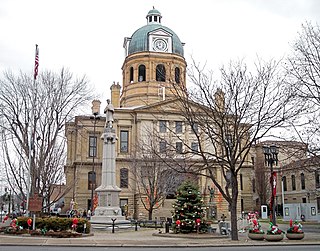
Tuscarawas County is a county located in the northeastern part of the U.S. state of Ohio. As of the 2020 census, the population was 93,263. Its county seat is New Philadelphia. Its name is a Delaware Indian word variously translated as "old town" or "open mouth". Tuscarawas County comprises the New Philadelphia–Dover, OH Micropolitan Statistical Area, which is also included in the Cleveland–Akron–Canton, OH Combined Statistical Area.
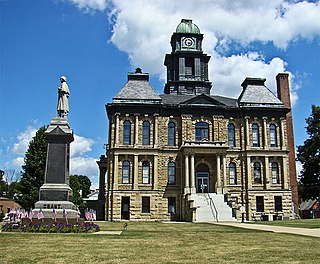
Holmes County is a county in the U.S. state of Ohio. As of the 2020 Census, the population was 44,223. Its county seat is Millersburg. The county was formed in 1824 from portions of Coshocton, Tuscarawas and Wayne counties and organized the following year. It was named after Andrew Holmes, an officer killed in the War of 1812.
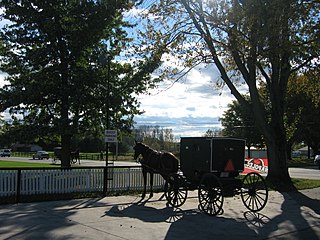
Shipshewana is a town in Newbury Township, LaGrange County, Indiana, United States. The population was 658 at the 2010 census. It is the location of the Menno-Hof Amish & Mennonite Museum, which showcases the history of the Amish and Mennonite peoples.
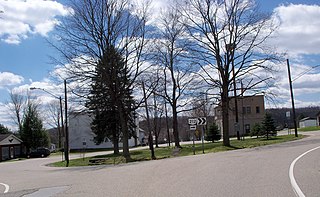
Leesville is a village in southwestern Carroll County, Ohio, United States. The population was 127 at the 2020 census. It is part of the Canton–Massillon metropolitan area.

Middlefield is a village in Geauga County, Ohio, United States. The population was 2,748 at the 2020 census. It is part of the Cleveland metropolitan area. Middlefield is known for being the center of the world's fourth largest Amish settlement, and its significant manufacturing base, which includes Gold Key Processing, Inc., Duncan Toys and KraftMaid. Because of its central location, home of the areas' public schools and prominent business and retail presence, Middlefield village is considered the hub community for Huntsburg, Parkman, and Middlefield Townships.
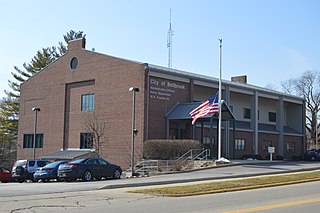
Bellbrook is a city in Greene County, Ohio, United States. The population was 7,317 at the 2020 census. It is part of the Dayton Metropolitan Statistical Area. It sits about 10.7 miles (17.2 km) southeast of Dayton.

Bergholz is a village in northwestern Jefferson County, Ohio, United States. The population was 544 at the 2020 census. The village's name is German and translates to "mountain timber". It is part of the Weirton–Steubenville metropolitan area.

East Sparta is a village in southern Stark County, Ohio, United States. The population was 749 at the 2020 census. It is part of the Canton–Massillon metropolitan area.

Navarre is a village in southwestern Stark County, Ohio, United States. The population was 1,846 at the 2020 census. It is part of the Canton–Massillon metropolitan area.

Bolivar is a village in Tuscarawas County, Ohio, United States. The population was 1,000 at the 2020 census. Bolivar is also home to Fort Laurens, the only American Revolutionary War-era fort in what is now Ohio.

Mineral City is a village in Tuscarawas County, Ohio, United States. The population was 652 at the 2020 census.

Newcomerstown is a village in Tuscarawas County, Ohio, United States, 85 miles (137 km) east-northeast of Columbus. The population was 3,702 at the 2020 census.

Port Washington is a village in Tuscarawas County, Ohio, United States. The population was 548 at the 2020 census.

Strasburg is a village in Tuscarawas County, Ohio, United States. The population was 2,735 at the 2020 census.

Tuscarawas, originally Trenton, is a village in Tuscarawas County, Ohio, United States. The population was 1,035 at the 2020 census.

Baltic is a village in Coshocton, Holmes, and Tuscarawas counties in the U.S. state of Ohio. The population was 851 at the 2020 census.

Plain City is a village in Madison and Union counties in the U.S. state of Ohio, along Big Darby Creek. The population was 4,065 at the 2020 census.
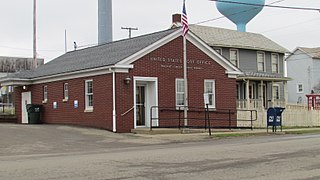
Walnut Creek is an unincorporated community and census-designated place in central Walnut Creek Township, Holmes County, Ohio, United States. As of the 2020 census, it had a population of 908. Located in Ohio's Amish Country, Walnut Creek is a popular location for tourists.

Sugar Creek Township is one of the sixteen townships of Wayne County, Ohio, United States. The 2020 census found 7,187 people in the township.

The Ohio Amish Country, also known simply as the Amish Country, is the second-largest community of Amish in the world, with in 2023 an estimated 84,065 members according to the Young Center for Anabaptist and Pietist Studies at Elizabethtown College. Ohio's largest Amish settlement is centered around Holmes County and in 2023 included an estimated 39,525 children and adults, the second largest in the world and the highest concentration of Amish in any US county; the Amish make up half the population of Holmes County, with members of other closely related Anabaptist Christian denominations, such as the Mennonites, residing there as well. The second largest community in Ohio is centered around Geauga County.

























